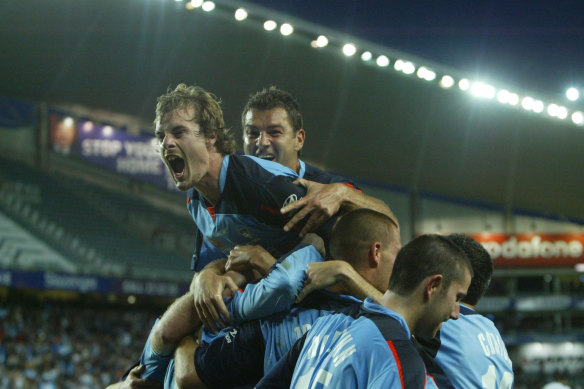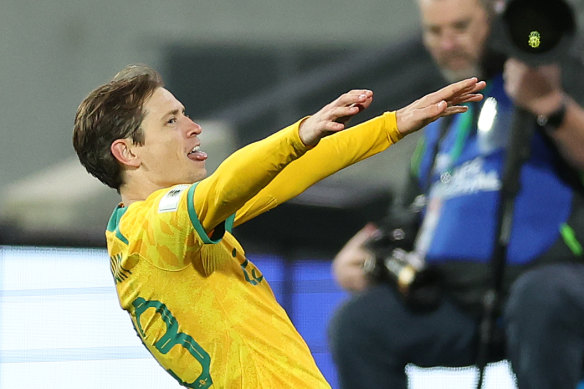

On Tuesday night, they face the Socceroos at Saitama Stadium, and their likelihood of victory is roughly the same. Their squad features players from clubs such as Liverpool (Wataru Endo), Monaco (Takumi Minamino) and Sporting Lisbon (Hidemasa Morita), and there are others from Arsenal (Takehiro Tomiyasu), Bayern Munich (Hiroki Ito) and Celtic (Kyogo Furuhashi) who are either injured or not required.
“Football here is amazing – especially the last few years,” said Socceroos defender Kye Rowles, a first-time visitor to Japan.
Japanese star Kaoru Mitoma, who plays for Brighton in the Premier League.Credit: Getty
“Obviously, the game and the league here is at a really strong point. We’ve got a couple of boys over here … you keep up to date with things over here because you’re keen on how your boys are doing as well.
“It’s just overall top quality. And yeah, I’d love to play here as well, to be honest.”
If you can’t beat them, join them?
It can all be traced back to 1999, six years after the launch of the J.League, when the competition’s governing body unveiled a 100-year plan for football. Their vision: to have 100 professional clubs in Japan by 2092, which would be the league’s 100th season, and for those clubs to stitch themselves into the fabric of their local communities.
Twenty-five years in, they are ahead of schedule: they have 60 professional clubs across three tiers of football, connected through promotion and relegation, underpinned by a thriving high school and university system in full alignment, largely unchallenged by any sports aside from baseball, which remains Japan’s undisputed number one sport. It has created a phenomenal strength in depth to the point where Japan’s B and C teams would probably be in the mix for World Cup qualification through Asia, if they could enter multiple sides.

Australia’s A-League started in 2005 amid much fanfare.Credit: Brendan Esposito
Meanwhile, the A-League launched in 2005 with eight clubs (one based in New Zealand). Now it has 13 (with a second Kiwi outfit, Auckland FC, beginning this season), and still nothing below it; the radio silence continues over Football Australia’s plans for a national second division next year. And even if it happens, there won’t be promotion and relegation for at least another decade.
It’s easy to point at the discrepancies and howl at the moon over the incompetence of Australian administrators, but there’s a few obvious, unchangeable factors behind all of this. For example, Japan has a population of 125 million. That’s five times bigger than Australia (26 million), which means not only a deeper talent pool, but more potential fans, sponsors and clubs … more everything.
Plus, you could fit Japan’s landmass into Australia’s 20 times over, which means it is far easier (and cheaper) for that bigger population to move about compared to us. Crucially, that makes it so much easier for their best young players to be exposed to one another in regular competition, while Australian soccer contrives all sorts of politically unpalatable workarounds to the sheer enormity of this continent. So even if the powers that be came up with a plan, executing it is another challenge entirely.

Craig Goodwin and the Socceroos face a tough test in Japan.Credit: Getty Images
Then again … at least they have a plan. The closest thing the Australian game has had to a blueprint for the future is the old ‘Whole of Football Plan’ released by David Gallop and the then-FFA in 2015. It was supposed to be a 20-year plan. We should be nearly halfway through it – but that plan was thrown out the window some time ago during the civil war for the A-League’s independence. These days, Football Australia has its XI Principles (not so much a plan with measurable targets than a long to-do list), while every state federation below does its own thing, at its own pace.
The A-League, meanwhile, lurches from one crisis to the next, with seemingly no plan for today, let alone a road map for tomorrow. Some things aren’t a mystery.
That’s the bigger-picture perspective, which explains why the Socceroos shouldn’t stand a chance in Saitama, and why they’ve beaten Japan only once since Cahill’s brace in Germany.
Loading
The smaller picture consists of a round ball, two teams of 11 players, and a rectangular field where anything can happen on a given night. And it doesn’t account for the newfound belief running through Tony Popovic’s new-look team, or the fact that Australian sides tend to do their best work playing on the counter-attack against more fancied opponents, rather than being forced to make the play against teams they “should” be beating.
“The last few years, they’ve had our number,” Rowles said.
“It’s massively important this game, and especially being almost the halfway point in the qualification process, we need to start getting the ball rolling. Hopefully, we can flip the script a little bit and put in a good performance and get one back on them.”




